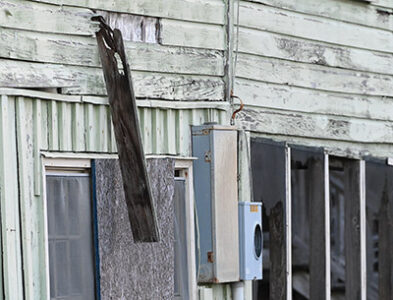Pawleys Island
Ruling sets stage for removal of house that’s beyond shabby

A house that is dilapidated far beyond the “arrogantly shabby” level that was once a source of pride on Pawleys Island will be torn down – as soon as it has a new owner.
The Tyson house sits on a curve overlooking the marsh on Myrtle Avenue just south of Town Hall. The electric meter was removed a few years ago. Since then broken windows and doors left it open to varmints and vandals. Town Council fielded a steady stream of complaints from neighbors and other island property owners.
Mayor Brian Henry got repeated assurances that the house would be secured and cleaned up if not actually repaired. When little or nothing happened, the town drafted an ordinance that would allow it to condemn the property and assess the owner for the cost if it was found to be a nuisance and not corrected.
The ordinance was tabled before final reading because council members felt it was too drastic.
Last week, the town Board of Zoning Appeals cleared the way for the demolition of the house by agreeing that the property is a lot of record. Although it doesn’t meet the minimum lot size in the town’s development code, a new house can still be built on the site.
“The question everyone wants answered is when is the house going to get torn down,” said Will Moody, a real estate agent who represents the family. He also chairs the Georgetown County Board of Zoning Appeals.
Verlene Tyson, who owned the house, died in the spring. The accountant who was named executor of her estate had retired, Moody said, so the family had to have a new one appointed by the Probate Court.
The estate can’t afford to tear the house down, he said, but wants to sell the property to someone who will. To do that, it needed to confirm that a new owner can build a new house.
“It’s a first step in getting the house torn down,” Moody said.
It was a welcome step.
Patty Hunter, who bought the house next door in 2020, urged the appeals board to approve the request.
“We continue to lose high-season renters,” she told the board in a written comment. “Please let’s move forward to rid ourselves of this horrible eyesore.”
She told the town two years ago that foxes were living in the house.
“We would love to see something happen to that property,” Eddie Wilder, who lives on the other side of the Tyson house, told the board.
The Tyson property has 5,685 square feet. The town requires a minimum lot size of 7,500 square feet, but makes a provision for lots that existed before the code was adopted.
“This property is one of many that don’t meet the 7,500 square foot requirement,” Town Administrator Dan Newquist said.
Applying all the setbacks –20 feet in the front, 15 at the back and 7 on the sides – leaves a building footprint of 2,274 square feet. The house would have to be elevated 16 feet to meet flood regulations, he added.
Board member Jerry Lieberman asked if approving the footprint would still result in a nonconformity.
“A new structure would become more in compliance,” Newquist said. “This is more of a procedural matter, in my view.”
Board member Byron York pointed out that the current side setback is only 5 feet. He wondered if 7 feet is enough.
“I’m totally sympathetic with the neighbors,” York said.
The side setbacks conform to the development code, Newquist said, as do the front and rear setbacks.
“This will be a great improvement,” said Harold Wyatt, who chairs the board.
Board member Heide Johnson questioned whether a new owner could seek a variance to the setback or other provisions in the code.
“They could ask,” board member Peter Fawcett said.
“I can’t see a reason why you would grant further variances,” Newquist said.
The building footprint approved unanimously by the appeals board will be on file with the town, which would review plans for a new house for compliance with its architectural guidelines.
After the vote, Lieberman suggested the town demolish the house and charge the owners. That’s the process that the proposed nuisance ordinance would have established, but the demolition would only come as a last step after the owners were notified and given the chance to correct the problem. Ross DuRant, an assistant town attorney, said at the time the ordinance was introduced that the process would take about six months.
“It’s an eyesore, everybody agrees,” Lieberman said. “I think it would sell better as a clean lot.”
Moody said he expected that the sale price for the property would be reduced by the cost of the demolition.




